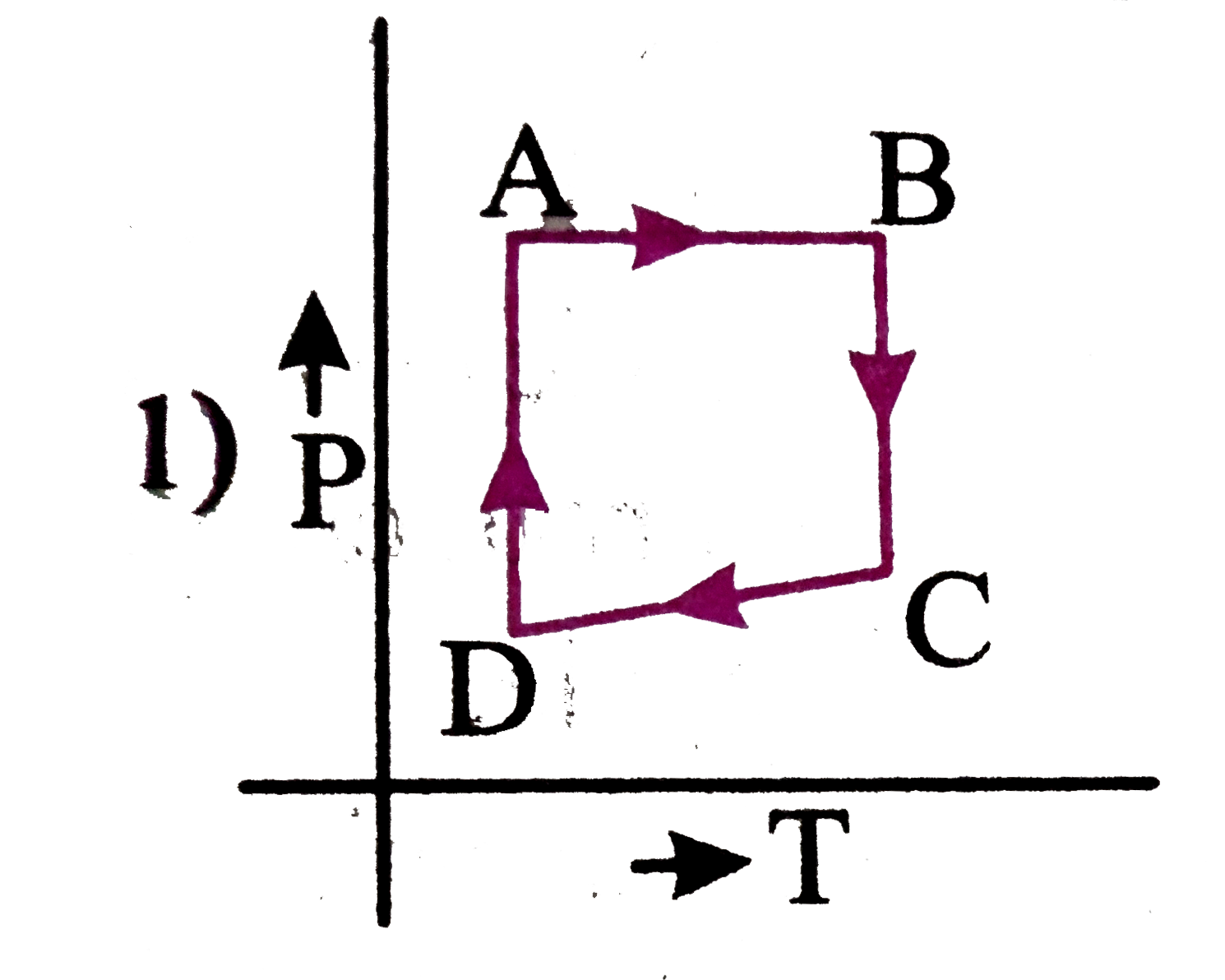For a cyclic process
W = 0
ΔE=0
ΔH≠0
ΔE≠0
The correct Answer is:B
Step-by-Step Solution
1. Understanding the Cyclic Process:
- In a cyclic process, a system returns to its initial state after undergoing a series of changes. This means that the properties of the system, such as internal energy (E), temperature (T), and pressure (P), will be the same at the beginning and end of the process.
2. Work Done in a Cyclic Process:
- The work done (W) during a process can be represented graphically on a Pressure-Volume (PV) diagram. The work done by the system is equal to the area enclosed by the path of the process on the PV diagram.
- For a cyclic process, the system returns to its initial state, and thus the net work done over one complete cycle is equal to the area enclosed by the path on the PV diagram.
3. Calculating Work Done:
- Since the system returns to its initial state, the total work done over one complete cycle is zero. This is because the work done on the system in one direction is equal to the work done by the system in the opposite direction, resulting in no net work.
4. Change in Internal Energy (ΔE):
- The change in internal energy (ΔE) for a cyclic process is also zero. This is because internal energy is a state function, and since the system returns to its initial state, the change in internal energy is zero (ΔE = E_final - E_initial = 0).
5. Conclusion:
- Therefore, for a cyclic process, both the work done (W) and the change in internal energy (ΔE) are zero. The correct answer to the question is that the work done (W) is equal to zero.
Summary of Key Points:
- Work done in a cyclic process is zero (W = 0).
- Change in internal energy in a cyclic process is also zero (ΔE = 0).
- In a cyclic process, a system returns to its initial state after undergoing a series of changes. This means that the properties of the system, such as internal energy (E), temperature (T), and pressure (P), will be the same at the beginning and end of the process.
- The work done (W) during a process can be represented graphically on a Pressure-Volume (PV) diagram. The work done by the system is equal to the area enclosed by the path of the process on the PV diagram.
- For a cyclic process, the system returns to its initial state, and thus the net work done over one complete cycle is equal to the area enclosed by the path on the PV diagram.
- Since the system returns to its initial state, the total work done over one complete cycle is zero. This is because the work done on the system in one direction is equal to the work done by the system in the opposite direction, resulting in no net work.
- The change in internal energy (ΔE) for a cyclic process is also zero. This is because internal energy is a state function, and since the system returns to its initial state, the change in internal energy is zero (ΔE = E_final - E_initial = 0).
- Therefore, for a cyclic process, both the work done (W) and the change in internal energy (ΔE) are zero. The correct answer to the question is that the work done (W) is equal to zero.
- Work done in a cyclic process is zero (W = 0).
- Change in internal energy in a cyclic process is also zero (ΔE = 0).
Topper's Solved these Questions
- THERMODYNAMICS AND THERMOCHEMISTRY BOOK - ERRORLESS CHAPTER - THERMODYNAMICS AND THERMOCHEMISTRY EXERCISE - ORDINARY THINKING (Objective Questions) First law of thermodynamics and Hess law
100 Videos
- THERMODYNAMICS AND THERMOCHEMISTRY BOOK - ERRORLESS CHAPTER - THERMODYNAMICS AND THERMOCHEMISTRY EXERCISE - ORDINARY THINKING (Objective Questions) Heat of reaction
174 Videos
- SOME BASIC CONCEPTS OF CHEMISTRYBOOK - ERRORLESS CHAPTER - SOME BASIC CONCEPTS OF CHEMISTRYEXERCISE - JEE Section (Matrix Match type questions)
3 Videos
Similar Questions
Knowledge Check
An ideal gas is subjected to a cyclic process ABCD as depicted in the P-V diagram given below

Which of the following curves represents the equivalent cyclic process?A B
B C
C D
D
One mole of an ideal gas undergoes a cyclic process abca, as shown in figure. If ab is isothermal process, then which of the following is correct P−Tdiagram for the cyclic process ?
 A
A B
B C
C D
D
A : Heat absorbed in a cyclic process is zero.
R : Wrok done in a cyclic process is zero.AIf both Assertion & Reason are true and the reason is the correct explantion of the assertion, then mark(1)BIf both Assertion & Reason are true but the reason is not the correct explanation of the assertion, then mark (2).CIf Assertion is true statement but Reason is false, then mark (3).DIf both Assertion and Reason are false statements, then mark (4)
What is cyclic process? Prove that the net work done durng a cyclic process is numerically equal to the area of the loop representing the cycle.
View SolutionExamples on thermodynamic processes||Cyclic process||Efficiency OF a cyclic process
View SolutionWhat is a cyclic process ?
View SolutionAssertion : In a cyclic process ΔU=0.
Reason : Cyclic process represents equilibrium state.
View SolutionAssertion:− −q=−W for cyclic process.
Reason:− Temperature remain constant during cyclic process.
View Solution

